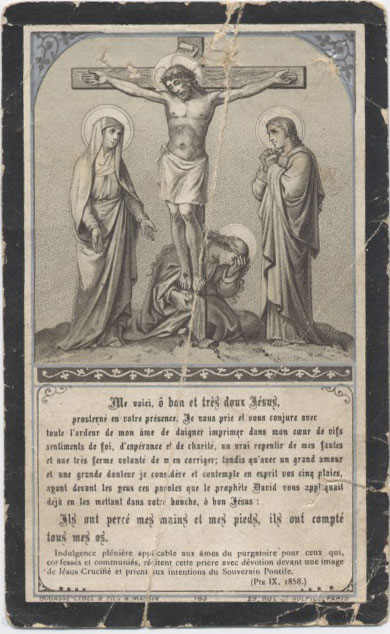In an earlier post I told the story of Philibert Racine alias Philip F. Root. Philibert was a Canadien veteran of the Civil War and the brother of two of my great-great-grandmothers. He served with the First Vermont Battery Light Artillery that saw action in the Red River campaign in Louisiana.
I mentioned in that post that Philibert reportedly had a brother who called himself George S. Root who served in this same unit in the Civil War. I surmised that “George” was an alias for Cyprien Racine, baptized May 30, 1843 at Saint-Damase-de-Saint-Hyacinthe, Québec. I believe that I can now confirm the theory that George S. Root was Cyprien.
In the records of the U.S. National Archives I find the following pension document recording the February 25, 1928 death of a George S. Root.
The record appears to indicate that George S. Root’s rank was Artificer, that he served in the 1st (Independent) Battery Vermont Light Artillery, and gives his place of death as Mendon, Michigan.
The place of death was significant since I had information from Racine genealogist extraordinaire, Jules Racine of Québec, that another brother of Philibert, Charles Appolinaire Racine, had contracted his second marriage in Mendon, St. Joseph County, Michigan.
I turned to the 1920 U.S. Federal Census, eight years prior to the veteran’s death, and found a George S. Root living with his wife Lucy in Mendon Township, MI. The census reports that George was born in Canada, his mother tongue was French, and that the same is true of both of his parents.
The census gives his age as 75 on January 9 or 10th of 1920, which, assuming he hadn’t yet had his birthday that year, yields a birth year of 1844. Tracing George and Lucy back through the U.S. Census of Mendon, MI, I find that George, a farmer by trade, in 1900 gives his month and year of birth as May 1844.
This is reasonably close to the May 1843 date of birth of Cyprien Racine, given that these discrepancies are often found in the census records. The information in the census seems fairly consistent with my theory that George and Cyprien are the same person.
In 1880 I find George, Lucy and family in nearby Leonidas, MI. Here we learn that the couple had three daughters Mary, 9, Catherine, 7, and Virginia, 2. The two older girls were born in Kansas, while the youngest was born in Michigan. This places George and Lucy in Kansas from about 1871 to about 1873 but likely back in Michigan by 1878 or so.
Searching for the marriage record of George and Lucy, I find a wedding at Mendon, MI on May 27, 1869 of a George Root, born in Canada, to a Lucia Monton (also Mouton or Moutaw) born in Mendon. The age of the groom is recorded as 24, which is consistent with a birth year of 1844 or 1845.
The final document in this series is an application to the U.S. War Department for a veteran’s headstone made by Mrs. Virginia Lighthiser, most likely George S. Root’s daughter whom we met as a two-year-old in the 1880 census.
This record confirms that a George S. Root, who had close kin named Virginia, served in the Civil War in the First Vermont Battery Light Artillery, died on February 25, 1928, and is buried in Mendon, MI.
I have little doubt that my theory is correct that George S. Root is Cyprien Racine. I can now piece together the outline of his life.
I have little doubt that my theory is correct that George S. Root is Cyprien Racine. I can now piece together the outline of his life.
Born in Québec in 1843, his family lived briefly in Richford, Vermont, on the Québec border, in the late 1840s and early 1850s before they eventually settled in Roxton Falls, QC. By 1861, Cyprien, says the Canadian census of Roxton Falls in that year, is back in the United States.
In January 1862, at the age of 18, he enlisted for service in the American Civil War and served until August 1864. He appears to have returned to Canada but, by 1869, he is married in Michigan to a woman from that state.
The family spends the earlier portion of the 1870s in Kansas before returning to St. Joseph County, Michigan. George’s is a farm family and he lives for most of his days in his wife’s hometown where he dies, at age 84, and is buried.
His brother Philibert lived in a Franco-American enclave in Brunswick, Maine, but George did not live among other Canadiens. Philibert used his Yankee alias, Philip F. Root, when it suited him and reverted to his ancestral Racine identity when that served him better.
His tombstone in St. John’s Catholic Cemetery in Brunswick reads “Philibert Racine” while the document above indicates that Cyprien's government issue headstone reads "George S. Root."
His tombstone in St. John’s Catholic Cemetery in Brunswick reads “Philibert Racine” while the document above indicates that Cyprien's government issue headstone reads "George S. Root."
I see no evidence that Cyprien ever used his French name after coming to the States. The census says that he was a naturalized U.S. citizen and he was so not only by law, but also de facto.
Cyprien Racine, the son of a man who fought for the liberté of Québec in the Rebellion of 1837, became Grand Army of the Republic veteran and Midwestern farmer George S. Root.



















_Contents+Page.JPG)
